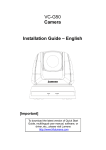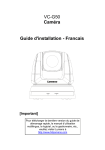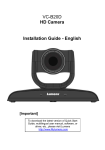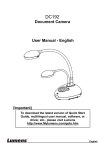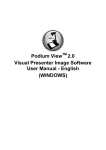Download VC-A20P HD Camera Installation Guide
Transcript
VC-A20P HD Camera Installation Guide - English [Important] To download the latest version of Quick Start Guide, multilingual user manual, software, or driver, etc., please visit Lumens http://www.Mylumens.com/support.php Table of Contents Copyright Information ..................................................................................................... 2 Chapter 1 Safety Instructions ......................................................................................... 3 Precautions .................................................................................................................................... 3 Chapter 2 Package Contents .......................................................................................... 5 Chapter 3 Product Overview ........................................................................................... 6 3.1 Overview ........................................................................................................................................ 6 3.2 Description of LED indicator .......................................................................................................... 6 Chapter 4 Instruction for installation ............................................................................. 7 4.1 Preparation before installation ....................................................................................................... 7 4.2 Instruction for installation ............................................................................................................... 7 4.3 Connecting devices .....................................................................................................................13 Chapter 5 Remote Control and Setting Menu .............................................................. 17 5.1 Functions of remote control .........................................................................................................17 5.2 Setting menu ................................................................................................................................18 Chapter 6 Descriptions of Major Functions................................................................. 23 6.1 I would like to switch to VC-A20P ................................................................................................23 6.2 I would like to save the current lens position data.......................................................................23 6.3 I would like to clear the saved position data ................................................................................23 6.4 I would like to turn on the back light compensation function .......................................................23 6.5 I would like to adjust the shooting angle of the lens ....................................................................23 6.6 I would like to zoom in/out images...............................................................................................23 6.7 I would like to adjust the focal length ...........................................................................................23 6.8 I would like to adjust the AF speed ..............................................................................................23 6.9 I would like to set the image mode ..............................................................................................24 6.10 I would like to freeze images .......................................................................................................24 6.11 I would like to rotate the image ....................................................................................................24 6.12 I would like to change the camera direction ................................................................................24 6.13 I would like to display the current status......................................................................................24 6.14 I would like to reset to the default value ......................................................................................24 Chapter 7 Network Function Settings Description ..................................................... 25 7.1 Online IP Camera ........................................................................................................................25 7.2 Web Page Function Description ..................................................................................................27 Chapter 8 DIP switch setting ......................................................................................... 32 8.1 DIP SWITCH ................................................................................................................................32 8.2 RS-422 Connection......................................................................................................................33 Chapter 9 Troubleshooting ........................................................................................... 35 English - 1 Copyright Information Copyrights © Lumens Digital Optics Inc. All rights reserved. Lumens is a trademark that is currently being registered by Lumens Digital Optics Inc. Copying, reproducing or transmitting this file is not allowed if a license is not provided by Lumens Digital Optics Inc. unless copying this file is for the purpose of backup after purchasing this product. In order to keep improving the product, Lumens Digital Optics Inc. hereby reserves the right to make changes to product specifications without prior notice. The information in this file is subject to change without prior notice. To fully explain or describe how this product should be used, this manual may refer to names of other products or companies without any intention of infringement. Disclaimer of warranties: Lumens Digital Optics Inc. is neither responsible for any possible technological, editorial errors or omissions, nor responsible for any incidental or related damages arising from providing this file, using, or operating this product. English - 2 Chapter 1 Safety Instructions Please use the product following the safety instructions below: 1 Operation 1.1 1.2 1.3 1.4 1.5 1.6 Please use the product in the recommended operating environment. Do not place Light Engine in tilted position. Do not place the product on an unstable trolley, stand or table. Do not use this product near water or source of heat. Use attachments only as recommended. Use the type of power source indicated on the HD Camera. If you are not sure of the type of power available, consult your dealer or local electricity company for advice. 1.7 Always take the following precautions when handling the plug. Failure to do so may result in sparks or fire. Ensure the plug is free of dust before inserting it into a socket. Ensure that the plug is inserted into the socket securely. 1.8 Do not overload wall sockets, extension cords or multi-way plug boards to avoid potential risks. 1.9 Do not block slots and openings in the case of this product as poor ventilation may lead to overheating of this product. 1.10 Except as specifically instructed in this User Manual, do not attempt to open or remove covers by yourself. It may expose you to electric shock or other hazards. Refer all servicing to licensed service personnel. 1.11 Unplug this product from the wall outlet and refer servicing to licensed service personnel when the following situations happen: If the power cords are damaged or frayed. If liquid is spilled into the HD Camera or the HD Camera has been exposed to rain or water. 2 Installation 2.1 For security considerations, please make sure the standard hanging rack you bought is in line with UL or CE safety approbations and installed by technician personnel approved by agents. 3 Storage 3.1 Do not place the HD Camera where the cord can be stepped on as this may result in fraying or damage to the lead or the plug. 3.2 Never push objects of any kind through cabinet slots. Never allow liquid of any kind to spill into the HD Camera. 3.3 Unplug this product during thunderstorms or if it is not going to be used for an extended period. 3.4 Do not place this product or accessories on top of vibrating equipment or heated objects. 4 Cleaning 4.1 Unplug all the cables before cleaning. Use a damp cloth for cleaning. Do not use liquid or aerosol cleaners. 5 Remote control (if the accessories are equipped with remote control) 5.1 Using an incorrect battery type in the remote control may result in breakdown. Follow local instructions on how to dispose of used batteries. Precautions Warning: To reduce the risk of fire or electric shock, do not expose this appliance to rain or moisture. If HD Camera will not be used for an extended time, unplug it from the power socket. Note Risk of Electric Shock Please do not open it by yourself. Caution: To reduce the risk of electric shock, do not remove cover (or back). No user-serviceable parts inside. Refer servicing to licensed service personnel. This symbol indicates that this equipment may contain dangerous voltage which could cause electric shock. This symbol indicates that there are important operating and maintenance instructions in this User Manual with this unit. English - 3 FCC Warning This HD Camera has been tested and found to comply with the limits for a Class A digital device, pursuant to Article 15-J of FCC Rules. These limits are designed to provide reasonable protection against harmful interference in a commercial installation. This digital apparatus does not exceed the Class A limits for radio noise emissions from digital apparatus as set out in the interference-causing equipment standard entitled "Digital Apparatus," ICES-003 of Industry Canada. EN55022 (CE Radiation) Warning This product is intended for use in a commercial, industrial, or educational environment. It is not intended for residential use. This is a Class A product. In a residential environment it may cause radio interference, in which case the user may be required to take adequate measures. The typical use is in a conference room, reception room or hall. English - 4 Chapter 2 Package Contents VC-A20P Instruction for installation Remote control Power cord Power Adapter RS-422 Connector Metal Plate B M3 Screws Appearance may vary depending on country/region Metal Plate A English - 5 Chapter 3 Product Overview 3.1 Overview Front View 1. Camera lens 2. Power LED indicator 3. Standby LED indicator 4. OUTPUT Switch 5. IR SELECT Back View 6. USB port (for FW update) 7. Power input 8. Ethernet port 9. DVI output 10.RS-232 output Bottom 11.RS-232 input 12.RS-422 Connection 13.Audio In 14.C-VIDEO output 15.Camera Address Selectors 3.2 Description of LED indicator 3.2.1 Power: 3.2.1.1 No light: Power off 3.2.1.2 Green light: In use 3.2.1.3 Flickering green: Signal from the remote control is received; the indicator flickers every 0.5 second 3.2.2 Standby: 3.2.2.1 Orange: In standby mode 3.2.2.2 No light: Power on English - 6 Chapter 4 Instruction for installation 4.1 Preparation before installation Installation and connection of VC-A20P HD camera requires special skills. To install by yourself, please follow necessary steps, ensure steady and tight installation of the device, and pay attention to your safety to avoid any accident. 4.1.1 Ensure the safety of the installation environment. Please do not install the device on unstable ceiling or in a place where the device is in danger of falling to avoid any accident. 4.1.2 Please check whether accessories in the box are complete or not. Please contact the supplier for any shortage, and make sure to keep the accessories in the box intact. 4.1.3 Please choose a proper place for installation of VC-A20P in advance. Please determine an installation place according to the following requirements. 4.1.1.1 Confirm the position for the object to be captured. 4.1.1.2 Confirm whether the VC-A20P is set at a proper distance from other light sources. 4.2 Instruction for installation 4.2.1 I would like to install VC-A20P on the desk 4.2.1.1 Precautions for installation Please install the machine on a flat desk Do not grab the camera head by hand when handling the device Do not rotate the camera head by hand. Improper rotation may result in breakdown of the camera 4.2.1.2 Installation steps 1. Please adjust DIP switch at first prior to installation <Remark> Please refer to Chapter 8 DIP Switch Setting for the relevant descriptions on DIP switch. 2. Place the camera on a flat desk directly to ensure the normal vertical and horizontal operation of the machine English - 7 4.2.2 I would like to install VC-A20P on the ceiling 4.2.2.1 Prepare for the parts and equipment required during the installation 1. Accessories of VC-A20P in the box (metal plates A, B and M3 screw x 7) 2. Screw for locking on ceiling mounted hanger x 4 3. Drilling machine, screw driver, ladder 4.2.2.2 Camera Size Length x Width x Height: 174 x 173.8 x 182.7 mm Weight : 1.8 Kg 4.2.2.3 Max. rotation dimension of camera English - 8 4.2.2.4 Size Diagram 1. Metal plate B - ceiling side Metal plate B locking screw Metal plate B locking bolt M3 threaded hole M3 threaded hole M3 threaded hole Metal plate B - ceiling English - 9 2. Metal plate A - machine side Metal plate A locking screw Metal plate A - machine side English - 10 3. Bottom of machine 4.2.2.5 Precautions for installation 1. Before installation, please confirm the orientation of the machine relative to the object to be captured 2. It is recommended that the machine should be set at a distance of more than 1 meter away from the object to be captured. Please adjust for a best distance according to the magnification of the lens 1 meter ↑ 3. The machine (including metal plates) is weighed at about 2.5 kg. If it is to be installed on the ceiling, please use the hanger that has obtained UL security approval to prevent the machine from falling down 4. Please check whether the camera is installed securely on a regular basis English - 11 4.2.2.6 Installation steps 1. Please adjust resolution on DIP switch at first <Remark> Please refer to Chapter 8 DIP Switch Setting for the relevant descriptions on DIP switch. 2. Fix the metal plate A on the machine base with 4 M3 screws 3. Lock the metal plate B on ceiling mounted hanger ※Caution: (1) Please use the hanger that has obtained UL security approval (2) Please reserve the hole for the connecting wires of the camera 4. Combine the metal plate A and the metal plate B (1) Push the metal plate A up to the ceiling and then to the right to latch the metal plate B (2) Fix with 3 M3 screws English - 12 4.2.2.7 How to remove 1. Remove the connecting wires from the camera 2. Uninstall the camera together with the ceiling, loosen the three screws that fix the metal plates A and B and push to the left to remove the machine 3. Then remove the screws on the hanger and the machine 4.3 Connecting devices 4.3.1 Image output 4.3.1.1 Connecting to a HDTV/computer monitor (DVI) DVI cable Monitor or HDTV English - 13 4.3.1.2 Connecting to a TV (C-Video) C-Video Cable TV 4.3.1.3 Connecting to Internet Network cable Router or Hub <Remark 1> VC-A20P can be used with browsers, Lumens VMS, VLC and QuickTime after it is connected to the Internet. <Remark 2> For use of Lumens VMS, please refer to the User Manual for VMS Software. 4.3.1.4 Connecting AUDIO IN Microphone English - 14 4.3.2 Controlling VCs with the computer 4.3.2.1 Connecting to one computer for connection between VCs (RS-232 in/out) <Remark> With RS-232 in/out, at most 7 VCs can be connected. 4.3.2.2 Connecting to one computer for connection between VCs (RS-422) <Remark> Please refer to 8.2 RS-422 connection for the RS-422 connection instructions. <Remark> With RS-422, at most 7 VCs can be connected. 4.3.3 Use of VC-A20P with Internet Connection 4.3.3.1 Setup before use Connect DVI output to the screen. Press [MENU] on the Remote Control to display the OSD menu. Shift down to [Ethernet] to modify and confirm the IP address. DHCP: Enable/disable the dynamic host configuration protocol IP Address: Confirm or modify the IP address of VC-A20P Subnet mask: 255.255.255.0 Gateway: Preset 192.168.100.1 [Remark] Please modify the above settings based on the LAN setting of the operating environment. To use DHCP, please connect the VC-A20P to LAN and then confirm IP address. After completing settings, press [MENU] to exit the OSD menu. After completing setting and confirming IP address, DVI cable can be disconnected. English - 15 4.3.3.2 Start Using Connect network cable to VC-A20P network port to connect VC-A20P to LAN. Press [MENU] on the Remote Control to display the OSD menu. Open the browser, and enter the URL of VC-A20P in the address bar, e.g.: http://192.168.100.150 (default IP address) Enter administrator’s account and password Account: admin (Default) Password: 9999 (Default) Subnet mask: 255.255.255.0 Gateway: Preset 192.168.100.1 [Remark 1] For details, please refer to Chapter 7 Network Function Settings Description. [Remark 2] In addition to browsers, other software such as Lumens VMS, VLC and QuickTime can be used for operation. [Remark 3] For operation of Lumens VMS, please download the software and its user manual from Lumens website. English - 16 Chapter 5 Remote Control and Setting Menu 5.1 Functions of remote control <Remark> The below functions are listed alphabetically. Item Description ,,, Move the lens Back Light Turn on/off back light compensation Camera Choose 1 ~ 3 of VC-A20P select FocusManual / Far/Near Focus-Auto Freeze Home-Enter Turn on manual focus to adjust the focal length Auto focus Freeze the screen Go back to the main page / Execute Info Status information L/R L/R Direction / Normal Direction Set Menu Display OSD menu Mirror Rotate the image (OFF / Mirror / Flip / Mirror + Flip) Clear the Pan / Tilt setting Pan/Tilt Reset Picture Power Switch image effect (OFF / NEG / Black & White) Power switch Zoom-Fast Appoint an ID (0 ~ 9) to save the current position data Appoint an ID (0 ~ 9) to delete the current position data Adjust image size Zoom-Slow Fine-tune image size Preset Reset English - 17 5.2 Setting menu <Remark> Press [Menu] on the remote control to enter the setting menu; the bold underlined values in the following table are defaults. 1st Level 2nd Level 3rd Level Function Descriptions Major Items Minor Items Adjustment Values Mode 1. 2. 3. 4. 5. Exposure_ Comp. On / Off AE Level Exposure_ Comp. Level -6~0~5 The value can be adjusted only after Exposure_ Comp. is activated Exposure Shutter Pri Iris Pri Full Auto Shutter Pri Iris Pri Manual White Board 60/30 mode 50/25 mode 1/10000 1/10000 1/5000 1/5000 1/3000 1/3000 1/2500 1/2500 1/2000 1/1750 1/1500 1/1250 1/1000 1/1000 1/725 1/600 1/500 1/425 1/350 1/300 1/250 1/215 1/180 1/150 1/120 1/120 1/100 1/100 1/90 1/75 1/60 1/50 1/30 1/25 1/15 1/12 1/8 1/6 1/4 1/3 1/2 1/2 1/1 1. 2. 3. 4. 5. 6. 7. 8. Exposure mode setting Shutter priority setting 1/1 F1.8 F2.5 F3.6 F5.1 F7.2 F10.2 F14.4 F20.4 Iris setting English - 18 Manual Gain Manual Speed Manual Iris 1. 2. 3. 4. 5. 6. 7. 8. 9. 10. 11. 12. 13. 14. 15. 16. 0dB 2 dB 4 dB 6 dB 8 dB 10 dB 12 dB 14 dB 16 dB 18 dB 20 dB 22dB 24dB 26 dB 28 dB 30 dB Manually set the gain 60/30 mode 50/25 mode 1/10000 1/10000 1/5000 1/5000 1/3000 1/3000 1/2500 1/2500 1/2000 1/1750 1/1500 1/1250 1/1000 1/1000 1/725 1/600 1/500 1/425 1/350 1/300 1/250 1/215 1/180 1/150 1/120 1/120 1/100 1/100 1/90 1/75 1/60 1/50 1/30 1/25 1/15 1/12 1/8 1/6 1/4 1/3 1/2 1/2 1/1 1. 2. 3. 4. 5. 6. 7. 8. 1/1 F1.8 F2.5 F3.6 F5.1 F7.2 F10.2 F14.4 F20.4 Manually set the shutter Manually set the iris English - 19 1. 2. 3. 4. 5. 6. 7. 8. 9. 10. 11. 8 dB 10 dB 12 dB 14 dB 16 dB 18 dB 20 dB 22dB 24dB 26 dB 28 dB 12. 1. 2. 3. 4. 5. 6. 7. 8. 1. 2. 3. 4. 5. 6. 30dB F1.8 F2.5 F3.6 F5.1 F7.2 F10.2 F14.4 F20.4 Off 1 2 3 4 5 Mode 1. 2. 3. 4. 5. 6. 7. 8. 9. 10. 11. 12. 13. Auto Indoor Outdoor One Push WB ATW Manual Sodium lamp 3000K 4300K 5000K 6500K 8000K WidwAuto One Push Trigger ENTER Manual Blue 0~ C~128 Manual Red 0~ C~128 Adjustable when the white balance mode is set to Manual Adjustable when the white balance mode is set to Manual Picture effect 1. Off 2. Neg Set the picture effect Gain Limit Iris Limit WDR White Balance Picture Max. limit value of electron gain Max. limit value of iris WDR settings Select the color temperature mode 1. 4000k ~ 7000k 2. 3200k 3. 5800k 4. 1700k ~ 10000k 5. 1700k ~ 10000k 6. Custom 7. 2800k 8. 3000K 9. 4300K 10. 5000K 11. 6500K 12. 8000K 13. 3000k ~ 7000k One push trigger 3. B & W Sharpness 0~ C~15 Adjust the sharpness of the image English - 20 2D NR 3D NR Image Mode Image Mode Load Pan Tilt Zoom D-effect Auto Focus 1. 2. 3. 4. 5. 6. 7. 1. 2. 3. 4. 5. 1. 2. 3. 4. 5. 6. 7. 1. 2. 3. 4. 5. 6. Auto Off 1 2 3 4 5 Off Low Typ Max Auto Mode 1 Mode 2 Mode 3 Mode 4 Mode 5 Mode 6 Custom Mode 1 Mode 2 Mode 3 Mode 4 Mode 5 Mode 6 2D noise reduction settings 3D dynamic noise reduction settings The user may customize his/her desired image mode Adjustable when the image mode is set to Mode 5. After selected, the corresponding image mode parameters will be read and applied to Mode 5 Adjustable when the image mode is set to Custom Contrast adjustment; Adjustable when the image mode is set to Custom Adjustable when Image Mode is set to Mode 5. Brightness 0~ C~25 Contrast 0~ C~25 Saturation 0~ C~25 Black Level 1. 2. 3. 4. 5. 6. Gamma 0~ C~3 Skin Tone 0~ C~5 Adjustable when Image Mode is set to Mode 5. Set skin tone, Adjustable when Image Mode is set to Mode 5. Pan/Tilt Limit ON/Off Turn on/off the angle limit setting Pan Right Limit 0~170 Limit the right angle Pan Left Limit -170~0 Limit the left angle Tilt UP Limit 0~90 Limit the upward angle Tilt Down Limit -30~0 Limit the downward angle Mirror AF Sensitivity 1. 2. 3. 4. 1. 2. 3. Off Type 1 Type 2 Type 3 Type 4 Type 5 Off Mirror Flip Mirror + Flip Low Middle High Adjustable in the Custom Mode Set the mode at which the image is turned Select the AF triggering speed. The higher the speed is, the faster AF is triggered English - 21 AF speed Fast / Normal AF frame setting, when central area was set as AF frame, focusing will be on the center of the screen. When Full Frame was set as AF frame, focusing will be calculated based on the full screen Enable/Disable DHCP setting using left and right arrow keys and press [ENTER] to apply setting. Press [ENTER] to modify the items; select the item to be modified using left and right arrow keys, and modify the value using numeric keys. Press [ENTER] to modify the items; select the item to be modified using left and right arrow keys, and modify the value using numeric keys. Press [ENTER] to modify the items; select the item to be modified using left and right arrow keys, and modify the value using numeric keys. AF Frame Full Frame / Center DHCP On/Off IP Address 192.168.100.150 Subnet mask 255.255.255.0 Geteway 192.168.100.254 C-Video NTSC LB NTSC CP NTSC SQ PAL LB PAL CP PAL SQ Image mode Prompt On / Off Turn on/off the prompt information on the display IR Receive On / Off Turn on/off the infrared reception Language English / Chinese Language Ethernet Protocol 1. 1080p/60 2. 1080p/59.94 3. 1080p/50 4. 1080p/30 5. 1080p/29.97 6. 1080p/25 7. 1080i/60 8. 1080i/59.94 9. 1080i/50 10. 720p/60 11. 720p/59.94 12. 720p/50 Protocol V/ Protocol PD Factory Reset On / Off Resume the factory default setting FW Upgrade On / Off Upgrade Firmware System Output Mode Status Focus speed after AF triggering Set output resolution Protocol V: VISCA Protocol PD: PELCO D Display the current setting status English - 22 Chapter 6 Descriptions of Major Functions 6.1 I would like to switch to VC-A20P 1. Press [Camera 1 ~ 3] on the remote control to select VC-A20P. Camera 1 ~ 3 is selected with IR SELECT. 6.2 I would like to save the current lens position data 1. Hold [Preset + ID] on the remote control to save the current position data. ID shall be a digit [0 ~ 9]. Use VISCA Command to store position data to [0 ~ 127]. 6.3 I would like to clear the saved position data 1. Hold [Reset + ID] on the remote control to clear the given position data. ID shall be a digit [0 ~ 9]. Use VISCA Command to clear position data stored in [0 ~ 127]. 6.4 I would like to turn on the back light compensation function 1. Press [Back Light] on the remote control to turn on or turn off the back light compensation. 6.5 I would like to adjust the shooting angle of the lens 1. Press [Tilt ] or [Tilt ] on the remote control to adjust the angle upward or downward. 2. Press [Pan ] or [Pan ] on the remote control to adjust the angle to right or left. 3. Press [Pan - Tilt Reset] on the remote control to reset the angle to the center point. 6.6 I would like to zoom in/out images 6.6.1 Adjust image size 1. Press [Fast +] on the remote control to zoom in images. 2. Press [Fast -] on the remote control to zoom out images. 6.6.2 Fine-tune image size 1. Press [Slow +] on the remote control to zoom in images. 2. Press [Slow -] on the remote control to zoom out images. 6.7 I would like to adjust the focal length 6.7.1 Auto tune 1. Press [AF] on the remote control to adjust automatically. 6.7.2 Manual focus 1. Press [MF] on the remote control to turn on the manual focus function. 2. Press Focus - [+] or Focus - [-] to adjust. 6.8 I would like to adjust the AF speed 6.8.1 Adjust the AF Sensitivity Triggering speed of focus. The higher the speed is, the faster focus is triggered. To shoot fast-moving objects, AF Sensitivity can be set to [High] or [Middle], which is applicable to quick focus. English - 23 When the environment is too dark to enable auto focus or fixed objects have to be shot in different brightness, AF Sensitivity can be set to [Low]. 1. Press [MENU] to activate the setting menu. 2. Press [] or [] to select [Auto Focus]. 3. Press [ENTER] to activate. 4. Press [] or [] to select [AF Sensitivity]. 5. Press [ENTER] to activate. 6. Press [] or [] to select [High / Middle / Low]. 7. Press [MENU] to exit. 6.8.2 Adjust the AF speed The focus speed upon triggering AF Sensitivity [Normal] (default): Image flickering may not occur [Fast]: Fast focus speed 1. Press [MENU] to activate the setting menu. 2. Press [] or [] to select [Auto Focus]. 3. Press [ENTER] to activate. 4. Press [] or [] to select [AF speed]. 5. Press [ENTER] to activate. 6. Press [] or []] to select [Fast / Normal]. 7. Press [MENU] to exit. 6.9 I would like to set the image mode 1. Press [Picture] on the Remote Control to switch [Off/Neg/B&W]. 6.10 I would like to freeze images 1. Press [Freeze] on the remote control to freeze the current image on the display. 6.11 I would like to rotate the image 1. Press [Mirror] on the Remote Control to switch [Off / Mirror / Flip / Mirror + Flip]. 6.12 I would like to change the camera direction 1. Press [L/R Direction Set] on the remote control to switch [L/R Direction / Normal]. 6.13 I would like to display the current status 1. Press [Info] on the remote control to display the current status information. 6.14 I would like to reset to the default value Reset to default value using OSD menu or Remote Control combination key OSD menu: Press [MENU] [System] [Factory Reset] [On] [Enter] on the Remote Control and reset to the default value Remote Control combination key: press [+] [8] [8] [6] [Enter] one by one on the Remote Control in order to reset to the default value English - 24 Chapter 7 Network Function Settings Description 7.1 Online IP Camera 7.1.1 Connecting to Internet Two common connection methods are shown below 1. Connecting via switch or router Network cable Network cable VC-A20P Computer Switch or router 2. To connect directly through network cable, the IP address of the computer should be changed so that it is on the same network segment as the camera; for instance 192.168.100.x (preset for camera) Connection diagram Network cable VC-A20P Computer Change network settings 7.1.2 Use the web browser 1. Open the browser, and enter the URL of VC-A20P in the address bar, e.g.: http://192.168.100.150 (default IP address) 2. Enter administrator’s account and password to get started Account: admin (Default) Password: 9999 (Default) 3. <Remark> 1. “WebPlugin” must be installed before the first use. Please install the program after downloading according to instructions on the screen (as shown in the following figure). 2. Please login the computer as Administrator to install it. 3. After completing installation, please refresh the page. English - 25 7.1.3 Use VMS 1. Please download VMS software from Lumens website: http://www.Mylumens.com/support.php 2. After starting the software, use search function to find out available VC-A20P, or add a known VC-A20P IP address 3. Click VC-A20P in the list and start operation after connecting to network 7.1.4 Use RTSP player In addition to browser and VMS, other RTSP methods can be used for connection, such as VLC and Quick Time RTSP connection address: rtsp://VC IP Address:8557/h264 1. Open the software to enter URL: rtsp://192.168.100.150:8557/h264 7.1.5 Use RTMP connection Support RTMP connection. If RTMP server is set up, RTMP connection function can also be opened Please log into VC-A20P webpage to change RTMP of network setting as described in 7.1.1Use the Web Browser English - 26 7.2 Web Page Function Description 7.2.1 Login Screen Username: Account Password: Password Select Language: Select language from English, Traditional Chinese and Simplified Chinese Remember password: Remember the password so that you do not need to type it next time Login: Login 7.2.2 Preview Screen 4 1 3 2 1. Information about image encoding form and resolution 2. Preview window 3. Switch to Full Screen 4. Logout English - 27 7.2.3 Account management screen 1 2 3 4 1. Enter new username and password 2. Set the permissions: Description for permissions is listed in the following table 3 Apply 4. List of accounts: Edit: Change password and permission of new account Delete: Delete new account <Remark> Reference for User Permissions User Type Admin View images Y Settings Y User accounts Y management Operator Y Y N Viewer Y N N 7.2.4 Setting - image encoding setting 1 2 3 1. Camera name: Change camera name on this page 2. Select rate and encoding 3. Storage setting; for advanced settings, see 7.2.5 Setting---Advanced Settings for Image Encoding English - 28 7.2.5 Setting - advanced image encoding setting 1 2 3 4 5 1. Name of current connected camera 2. IP Ratio: Set IP Ratio, from 1 to 60 3. Force I Frame: Check this item to insert IDR frame into specified series flow and apply its setting. User’s setting will be reserved and displayed in GUI interface 4. Encode Preset: Auto: Select between speed and quality depending on the encoding method used (e.g. HIGH_SPEED mode for refresh rate of 60 frames per second and HIGH_QUALITY mode for high image quality) HIGH_SPEED: Refresh rate of 60 frames per second is available HIGH_QUALITY: Higher image quality can be obtained SVC: SVC opened encoding mode is applicable to RTSP series flow of 8601, 8602, 8603 and 8604 ports, different refresh rate for different ports. See remark 5. Preset Save <Remark> SVC connection address: rtsp://VC IP Address:Port/h264 1. 60Frame : rtsp://VC IP Address:8557/h264, e.g.: rtsp://192.168.100.150: 8557/h264 2. 30Frame : rtsp://VC IP Address:8601/h264, e.g.: rtsp://192.168.100.150: 8601/h264 3. 15Frame : rtsp://VC IP Address:8602/h264, e.g.: rtsp://192.168.100.150: 8602/h264 4. 7Frame : rtsp://VC IP Address:8603/h264, e.g.: rtsp://192.168.100.150: 8603/h264 5. 3Frame : rtsp://VC IP Address:8604/h264, e.g.: rtsp://192.168.100.150: 8604/h264 7.2.6 Setting - camera 1 2 3 1. Name of current connected camera 2. Adjust camera brightness / contrast / saturation / sharpness, etc. 3. Preset Save English - 29 7.2.7 Setting - Sound 1 2 3 4 5 1. Name of current connected camera 2. Turn on/off sound 3. Set Encode Type(AAC / G.711) 4. Set Encode Sample rate 5. Preset Save 7.2.8 Setting - date and time 1 2 3 4 1. Name of current connected camera 2. Current camera date and time 3. Set the Time: Manual setting/synchronous computer time/synchronous SNTP server time/time of automatic adjustment of daylight saving 4. Preset Save <Remark> SNTP server address: Please change in network setting English - 30 7.2.9 Setting - camera 1 2 4 5 3 6 7 1. Name of current connected camera 2. Network address of camera: Change of setting is available only when DHCP function of camera is turned off; please turn off DHCP function using VC-A20P screen menu, and for setting of each item of screen menu, see 5.2 Setting Menu 3. Set RTMP: Set connection address of RTMP depending on RTMP Server setting 4. Set RTSP: Enable/Disable Multicast <Remark> It is suggested to enable Multicast when the number of users online watching the live image simultaneously is more than 4. 5. Set SNTP: Set SNTP Server IP 6. Set HTTP port. The default Port value is 80 <Remark> Change of setting is available only when DHCP function of camera is closed 7. Preset Save English - 31 Chapter 8 DIP switch setting <Note> Please turn off the machine before changing DIP switch setting. 8.1 DIP SWITCH 8.1.1 OUTPUT Switch Output Mode Setting Output Mode 1920x1080/60p 1920x1080/50p 1920x1080/30p 1920x1080/25p 1920x1080/60i 1920x1080/50i 1280x720/60p 1280x720/50p 1080/59.94p 1080/59.94i 1080/29.97p 720/59.94p Setting 8.1.2 IR SELECT ID 1 Setting 2 3 8.1.3 Camera Address Selector Setting 0~7 8~9 Function Descriptions ID 0~7 Reserved English - 32 8.1.4 System Switch Setting DIP 1 DIP 2 DIP 3 DIP 4 Function Descriptions RS-232C/RS-422 selector OFF: RS-232C / ON: RS-422 Infrared signal output switch OFF: Off / ON: On Communication baud rate selector OFF: 9600 / ON: 38400 Reserved 8.2 RS-422 Connection 8.2.1 RS-422 Pin Description Pin NO. 1 2 3 4 5 6 7 8 9 Function RXD OUT RXD OUT + TXD OUT TXD OUT + GND RXD IN RXD IN + TXD IN TXD IN + <Note> Please connect IN+ to OUT+ when connecting to SONY products For non-SONY products, it may be necessary to connect IN+ to OUT- English - 33 8.2.2 Use RS-422 Connection 1. Hold the two sides of RS-422 connector and pull out in the direction shown by the arrow in the figure below 2. Peel off a section of copper wire (AWG Nos. 28 to 18) and insert it into the connector hole; then use flat screw driver to fix it 3. Insert the wired RS-422 connector back to the camera. Now the connection is completed <Note> When RS-422 connection is being used, do not use RS-232C connection. English - 34 Chapter 9 Troubleshooting This chapter describes problems you may encounter while using VC-A20P. If you have questions, please refer to related chapters and follow all the suggested solutions. If the problem still occurred, please contact your distributor or the service center. No. 1. 2. Problems Boot without power signal There is no image output from VC-A20P Solutions 1. Make sure you have plugged in the power cord. 2. Make sure the Service DIP switch is Off. 1. Check the power. 2. Check if DIP switch is properly set. Please refer to Chapter 8 DIP Switch Setting for related settings. 3. Make sure the display supports the output resolution; in general, the resolution is 1080p60/1080i60/720p60. 4. Replace the cables and make sure they are not faulty. 3. 4. 5. VC-A20P image is severely delayed Not working after changes to DIP Switch setting VC-A20P cannot be operated by remote control Please use 1080p or 720p 60/50 Hz signals rather than 25/30 Hz signals. After completing DIP Switch setting, unplug and reconnect the power cord and turn on the machine to change the setting. 1. Please confirm if the Camera Select on the remote control can be used together with the IR Select on VC-A20P. 2. Please prevent VC-A20P from direct sunshine. 3. Make sure the energy-saving bulb and the IR touch screen are as far as possible in order to avoid interference. 4. When several VC-A20P are connected in the same area, the operation of two remote controls at the same time may result in signal interference. It is recommended to use one remote control only. 6. The device cannot be controlled with Codec 1. Please consult the distributor to make sure the firmware version is the latest one. The steps to check version is as follows: 1.1 Press [MENU] on the remote control 1.2 Choose [Status] 1.3 Go to Page 5 of [System] 1.4 Make sure the firmware version is correct 2. Make sure the connection is correct (RS-232/422 Input). 3. Make sure System Switch DIP1 and DIP3 are correct. 7. The device cannot be controlled with RS-232/RS422 Whether the Internet can be used for operation 1. Make sure the connection is correct (RS-232/422 Input). 8. 2. Make sure System Switch DIP1 and DIP3 are correct. Please refer to Chapter 7 Network Function Description for the Internet usage English - 35




































